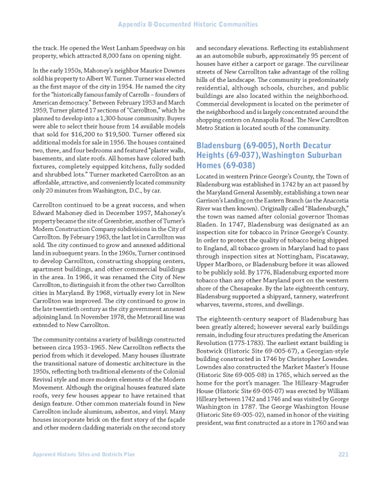Appendix B·Documented Historic Communities
the track. He opened the West Lanham Speedway on his property, which attracted 8,000 fans on opening night. In the early 1950s, Mahoney’s neighbor Maurice Downes sold his property to Albert W. Turner. Turner was elected as the first mayor of the city in 1954. He named the city for the “historically famous family of Carrolls – founders of American democracy.” Between February 1953 and March 1959, Turner platted 17 sections of “Carrollton,” which he planned to develop into a 1,300-house community. Buyers were able to select their house from 14 available models that sold for $16,200 to $19,500. Turner offered six additional models for sale in 1956. The houses contained two, three, and four bedrooms and featured “plaster walls, basements, and slate roofs. All homes have colored bath fixtures, completely equipped kitchens, fully sodded and shrubbed lots.” Turner marketed Carrollton as an affordable, attractive, and conveniently located community only 20 minutes from Washington, D.C., by car. Carrollton continued to be a great success, and when Edward Mahoney died in December 1957, Mahoney’s property became the site of Greenbrier, another of Turner’s Modern Construction Company subdivisions in the City of Carrollton. By February 1963, the last lot in Carrollton was sold. The city continued to grow and annexed additional land in subsequent years. In the 1960s, Turner continued to develop Carrollton, constructing shopping centers, apartment buildings, and other commercial buildings in the area. In 1966, it was renamed the City of New Carrollton, to distinguish it from the other two Carrollton cities in Maryland. By 1968, virtually every lot in New Carrollton was improved. The city continued to grow in the late twentieth century as the city government annexed adjoining land. In November 1978, the Metrorail line was extended to New Carrollton. The community contains a variety of buildings constructed between circa 1953–1965. New Carrollton reflects the period from which it developed. Many houses illustrate the transitional nature of domestic architecture in the 1950s, reflecting both traditional elements of the Colonial Revival style and more modern elements of the Modern Movement. Although the original houses featured slate roofs, very few houses appear to have retained that design feature. Other common materials found in New Carrollton include aluminum, asbestos, and vinyl. Many houses incorporate brick on the first story of the façade and other modern cladding materials on the second story
Approved Historic Sites and Districts Plan
and secondary elevations. Reflecting its establishment as an automobile suburb, approximately 95 percent of houses have either a carport or garage. The curvilinear streets of New Carrollton take advantage of the rolling hills of the landscape. The community is predominately residential, although schools, churches, and public buildings are also located within the neighborhood. Commercial development is located on the perimeter of the neighborhood and is largely concentrated around the shopping centers on Annapolis Road. The New Carrollton Metro Station is located south of the community.
Bladensburg (69-005), North Decatur Heights (69-037), Washington Suburban Homes (69-038) Located in western Prince George’s County, the Town of Bladensburg was established in 1742 by an act passed by the Maryland General Assembly, establishing a town near Garrison’s Landing on the Eastern Branch (as the Anacostia River was then known). Originally called “Bladensburgh,” the town was named after colonial governor Thomas Bladen. In 1747, Bladensburg was designated as an inspection site for tobacco in Prince George’s County. In order to protect the quality of tobacco being shipped to England, all tobacco grown in Maryland had to pass through inspection sites at Nottingham, Piscataway, Upper Marlboro, or Bladensburg before it was allowed to be publicly sold. By 1776, Bladensburg exported more tobacco than any other Maryland port on the western shore of the Chesapeake. By the late eighteenth century, Bladensburg supported a shipyard, tannery, waterfront wharves, taverns, stores, and dwellings. The eighteenth-century seaport of Bladensburg has been greatly altered; however several early buildings remain, including four structures predating the American Revolution (1775-1783). The earliest extant building is Bostwick (Historic Site 69-005-67), a Georgian-style building constructed in 1746 by Christopher Lowndes. Lowndes also constructed the Market Master’s House (Historic Site 69-005-08) in 1765, which served as the home for the port’s manager. The Hilleary-Magruder House (Historic Site 69-005-07) was erected by William Hilleary between 1742 and 1746 and was visited by George Washington in 1787. The George Washington House (Historic Site 69-005-02), named in honor of the visiting president, was first constructed as a store in 1760 and was
221
